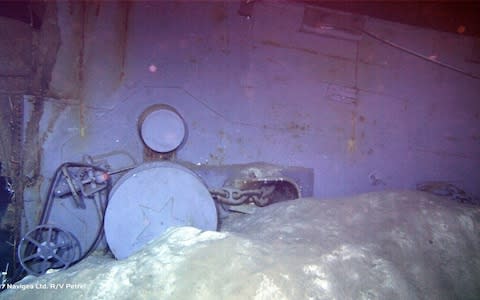Survivors hail discovery of the USS Indianapolis, 72 years after it was torpedoed with the loss of 880 lives

For decades survivors of the USS Indianapolis, sunk by Japanese torpedoes at the end of World War Two, believed the remains of the heavy cruiser and their ship mates would never be found.
But as news emerged that an underwater expedition had discovered the wreck 18,000 feet below the surface of the North Pacific Ocean, they described a mix of emotions as they remembered the hundreds of sailors and marines who died in one of America’s worst naval disasters.
Arthur Leenerman, a 93-year-old survivor, said her discovery had been a long time coming.
“I have wished for years that they would find it,” he said in a statement to USNI news. “The lost at sea families will feel pretty sad but I think finding the ship will also give them some closure.”
The Indianapolis was returning from a secret mission to deliver parts for the atomic bomb which was later used on Hiroshima when she was hit by Japanese torpedoes on July 30, 1945.
What came next made the episode one of the most retold tales of America’s war.
The vessel sank in just 12 minutes giving survivors little time to use rescue equipment. No distress call was ever received and it was not until four days later, when a bomber on a routine mission spotted survivors, that the alarm was raised.
Search teams rescued only 316 men of the 1196 on board, making it the largest single loss of life in the history of the US Navy. Hundreds survived the sinking but succumbed to dehydration, drowning or shark attacks.

The ship’s location remained a mystery, somewhere in the Philippine Sea between the island of Guam and Leyte Gulf.
Adolfo “Harpo” Celaya, who survived five days in the water without a life jacket clinging to a raft, said he had wondered for many years what had happened to the sinking ship and to his lost shipmates.
“I didn't think it was ever going to be found,” he told ABC15 in Arizona.
The story of the ship and her survivors has occupied a special place in the American psyche. They were the subject of countless books, documentaries and films.
The tale made for a chilling plot point in the Steven Spielberg blockbuster Jaws, when the fictional survivor Capt Quint describes the terror of waiting to be rescued while sharks snatched men in the water.

“When he comes at you he doesn’t seem to be living till he bites you and those black eyes roll over white,” he says.
Pail Allen, the Microsoft co-founder who has led the expedition to find the wreck, announced the discovery at the weekend.
“To be able to honour the brave men of the USS Indianapolis and their families through the discovery of a ship that played such a significant role in ending World War II is truly humbling,” he said.
The US Navy added that the Research Vessel Petrel continues to survey the site and that the work complies with American laws treating a sunken warship as a military grave.
Capt William Toti (Ret), spokesperson for the survivors of the USS Indianapolis, said: “They all know this is now a war memorial, and are grateful for the respect and dignity that Paul Allen and his team have paid to one of the most tangible manifestations of the pain and sacrifice of our World War Two veterans.”

 Yahoo News
Yahoo News 